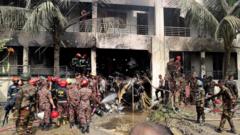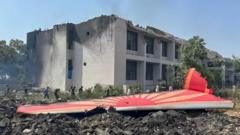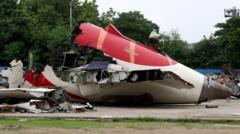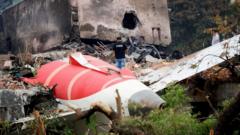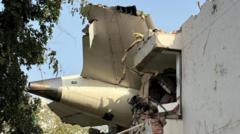The recent crash of an Air India flight near Ahmedabad illustrates the perilous intersection of urban development and aviation safety in rapidly growing Indian cities.**
Urban Growth Outpacing Safety at India’s Airports**

Urban Growth Outpacing Safety at India’s Airports**
As cities expand, increased risks loom for residents near bustling airports, highlighted by a recent tragic accident.**
In clouded skies, just above the bustling city of Ahmedabad, a tragic incident unfolded when an Air India flight crashed into a medical college campus, claiming the lives of 241 passengers and 34 residents. The serene moment of a family sharing lunch rapidly turned to horror as the flames from the downed aircraft were visible from their home, highlighting the stark risks as cities continue to burgeon around core infrastructure.
As urban areas in India swell, the lack of sufficient physical barriers between densely populated neighborhoods and airports creates a precarious situation, especially during the critical moments of takeoff and landing. While passenger air traffic has doubled within a decade, and the number of airports has risen significantly, existing urban landscapes have not been adequately adapted to accommodate this growth. The intertwining of aviation and densely populated cities poses an ever-increasing threat to public safety, underscoring the need for comprehensive urban planning that prioritizes the well-being of residents.
Ahmedabad's tragedy is far from isolated; it mirrors broader issues facing many cities in India, where the rapid pace of growth often leads to the erosion of safety standards. As the aviation sector expands, local authorities must reevaluate spatial planning, infrastructure development, and emergency response strategies to ensure that the ambition of modernization does not outstrip the capabilities of urban environments. As the nation charts its course toward growth, the lessons from Ahmedabad serve as a sobering reminder of the sometimes perilous consequences of unchecked expansion.
As urban areas in India swell, the lack of sufficient physical barriers between densely populated neighborhoods and airports creates a precarious situation, especially during the critical moments of takeoff and landing. While passenger air traffic has doubled within a decade, and the number of airports has risen significantly, existing urban landscapes have not been adequately adapted to accommodate this growth. The intertwining of aviation and densely populated cities poses an ever-increasing threat to public safety, underscoring the need for comprehensive urban planning that prioritizes the well-being of residents.
Ahmedabad's tragedy is far from isolated; it mirrors broader issues facing many cities in India, where the rapid pace of growth often leads to the erosion of safety standards. As the aviation sector expands, local authorities must reevaluate spatial planning, infrastructure development, and emergency response strategies to ensure that the ambition of modernization does not outstrip the capabilities of urban environments. As the nation charts its course toward growth, the lessons from Ahmedabad serve as a sobering reminder of the sometimes perilous consequences of unchecked expansion.










